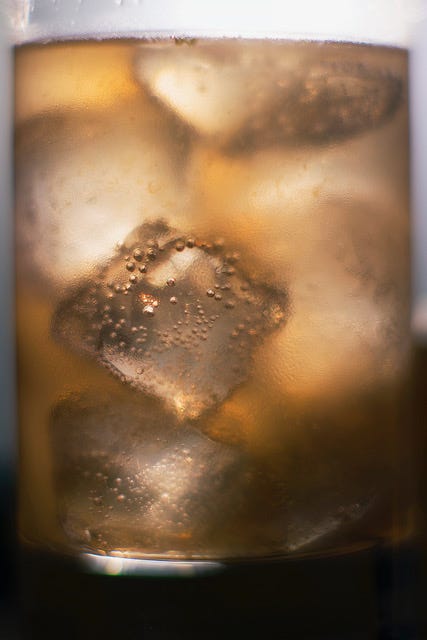Stompin' with Audrey
A cocktail for the weekend and a song to go with it
Audrey Saunders is an iconic bartender. She started her life’s work in the New York bar scene of the mid-1990s. Back then, the bar scene was mostly vodka bars. There were excruciatingly few bars featuring classic cocktails and fresh ingredients. She became a pioneer of the classical cocktail revival and worked at a couple of famous bars . In 2005 she opened the Pegu Club in New York’s Soho neighborhood. It was bar for the ages that focused on classic and creative cocktails. It was one of the few bars to feature cutting-edge mixology and, just as importantly, it made craft drinking accessible. In 2009 the club was awarded the Tales of the Cocktail hors for Best American Cocktail Bar and in 2011 she was nominated for American Bartender of the Year. The Pegu Club closed in 2020.
In an interview in Imbibe magazine, she reflected on her start in the business: "There was no 'movement' back then—there were only a handful of us preaching the gospel of craft in the hopes that it would eventually stick. By and large, most people were still experiencing sweet, fruity, flaccid mediocrity in a glass. That had always bothered me, because after personally experiencing the high degree of culinary expression that a cocktail could offer, I realized it wasn’t the experience of the majority of the public. And it was precisely because of my personal experiences with people like Dale [DeGroff, Saunders’ longtime mentor] and [London bartender] Dick Bradsell that I chose to take on this quest. When Pegu opened, every single drink needed to be perfect and delicious … and beyond that, you also needed to be wowed. Why? Because I was Dale’s kid, and folks had heard the hype. If those drinks weren’t amazing, and you weren’t wowed, you’d walk out the door thinking, “Nah, it wasn’t all that.” And that would have been the end of the movement that we were trying to bring to life."
Two of her cocktails have become classics: Old Cuban and Gin Gin Mule. The latter is our cocktail for the weekend. It is a fantastic cocktail.
Gin Gin Mule
6 fresh mint leaves
1 oz simple syrup
2 dashes Angostura bitters
.75 oz fresh lime juice
1.5 oz. (preferably a London Dry - Saunders preferred Tanqueray
1 oz ginger beer or to taste
Combine the lime juice, syrup, and mint in a mixing glass and muddle. Add the gin, ginger beer, and ice and shake a few seconds. Strain into a highball glass filled with ice. Garnish with mint leaves.
This is Saunders’ recipe that she used in her bars. But her ginger beer was house made and tasted different than commercial ginger beer. People have made adjustments by increasing the amount of ginger beer and/or adding it after the shake, either in the shaker or in the glass. Others make ginger syrup and add it and seltzer water. Others like it just the way it is written.
A Song to Accompany This Weekends Cocktail
On March 12, 1926, The Savoy Ballroom in Harlem, New York City opened its doors. It became a popular dance hall and remained that way through the 1950s. During that time is was influential in the development of swing dancing and music. It was, for example, where the Lindy Hop became famous. And, unlike other dance halls at the time, the Savoy Ballroom was one of the earliest to be racially integrated, with blacks and whites dancing together regularly.
Located between 140th and 141st Streets on Lenox Avenue, the two story building housed an enormous 10,000 square foot ballroom on its 2nd floor that spanned an entire city block. Approaching the Savoy, you walked through the entrance to the building at the middle of Lenox Avenue and you would ascend the central staircase to the dance floor. There were two bandstands along the eastern wall, and with two bands playing back-to-back, the music was continuous all night long with one band picking up when the other took a break.
Our song for the weekend was named after the Savoy Ballroom. It was written in 1933 by Edgar Sampson but is often credited to Benny Goodman, Chick Webb, Edgar Sampson, and Andy Razaf. It was first recorded by Chick Webb, then Benny Goodman, then Ozzie Nelson (yes, that Ozzie Nelson). Since then it has become a jazz standard and been recorded by hundreds of others. Lyrics were added later. Our version was recorded by the Benny Goodman Orchestra, one of the orchestras that played at the Savoy Ballroom.
Stompin At The Savoy
Written by Edgar Sampson, Produced by George Avakian, Arranged by Mel Powell,
Performed by the Benny Goodman Orchestra
Friday, finally Playlist on:
You probably have everything you need for next weekend’s cocktail on hand.
Here’s to Audrey Saunders and the difference she made.
Until next week…
Ff 127




